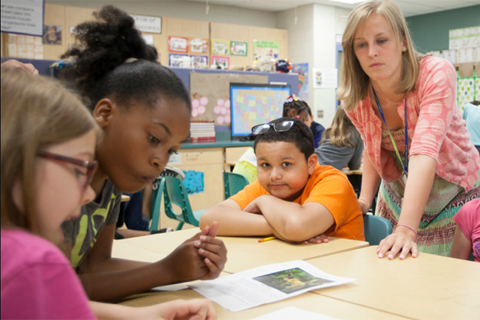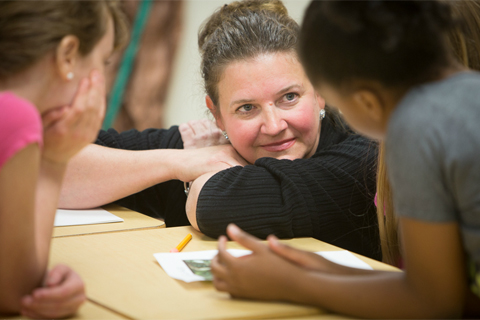By Kevin Knapp
Sometimes when Marcia Hudson looks at the well-worn school primer she displays as a keepsake in her Avondale School District office, she thinks about how the times have changed since her grandmother used that very book to teach elementary school.
Back in her day, the Three Rs — reading, writing and ’rithmetic — constituted the parameters of public education. Teachers simply followed the book and students presumably absorbed the lessons. There’s no question, says Hudson, a third-generation educator, her grandmother would be astonished at how the boundaries of public education have expanded.
“It’s a vastly different world now,” says Hudson. “The basics my grandmother taught are still important today but, as educators, we also have to realize that we are preparing kids for a future we don't have any comprehension of. We have to be visionaries, in our own way.”
That’s no empty claim.
Last October, Hudson, SEHS ’88, the district’s teacher leader, joined fellow educators, administrators and OU School of Education and Human Services (SEHS) faculty members in a quest to re-imagine elementary education by focusing on the whole child.
The Avondale district’s Auburn Elementary School was chosen to become a pioneering laboratory school. Officially known as the Avondale/Oakland University Partnership School, it is also a lab for teachers and teachers-to-be: a place to discover and use best practices for student learning, student-teacher education, and teacher-to-teacher learning.
OU professors routinely conduct their classes in instruction methodology to SEHS juniors and seniors at the Auburn lab school and also at the district’s Graham Elementary School. Ultimately, the plan is to expand the effort district-wide. OU students can immediately apply their newly acquired knowledge in real-world classroom settings under the supervision of practicing teachers and OU faculty members.
Trevor Cichowicz, an elementary education major from Troy, Mich., will begin his stint as a student teacher this fall, but he’s already been in front of a classroom at Auburn Elementary.
 |
| Fourth-grade teacher Sarah Bruha, SEHS '13, helps students with an assignment at Auburn Elementary School. |
“I think students can only learn so much from reading textbooks, attending classroom lessons, and writing papers,” he says. “What the partnership does is provide me with a first-hand opportunity to work with real students in a real classroom setting. It’s like what medical students do, learning from hands-on experiences with patients in hospitals.”
Wraparound services
A more groundbreaking concept has been the introduction of ancillary or “wraparound” services by the OU community, which aims to provide holistic support to Auburn students. For example, the
Oakland University William Beaumont School of Medicine promotes physical fitness and nutrition through its “Docs and Jocks” project.
The counseling department has made its counselors-in-training available to assist Auburn families. The departments of
Music, Theatre & Dance,
Modern Languages and Literatures,
Sociology, Anthropology, Social Work and Criminal Justice have also become involved in supporting the well being of those elementary students and families.
“Whether it’s a collaborative project with SEHS, the medical school, College of Arts and Sciences, or student organizations like the Student Michigan Education Association, the partnership community has found numerous ways to share learning resources and engage with one another in authentic, meaningful ways,” says Hudson.
Robert Maxfield, Ed.D., the interim dean of SEHS, says the partnership represents a new, honest, and open phase of what universities and schools can do together.
“Some might say, ‘this concept is nothing new.’ True, John Dewey established a lab school at the University of Chicago in the 1890s and so did some other universities, but they were all run top-down by the academies, which would typically march into the schools and tell teachers how they should teach. We consider what we’re doing a research partnership in which we’re truly equal partners. It’s a different approach that we think will yield different results.”
Giant step
The partnership concept is already drawing positive attention at the regional and state level. Some see it as a giant step toward the future of education and a model for teacher training.
 |
| Marcia Hudson, SEHS '88, sees the OU-Avondale partnership exploring bigger ideas in effective teaching methods. |
Deeming the project “revolutionary,” State Superintendent of Public Instruction Mike Flanagan, attending the school opening celebration ceremony last fall, said, “This is what all teachers need to prepare for their careers. This partnership can and will be the model for the future of schools.”
That view is one shared by Sarah Bruha, SEHS ’13, a fourth-grade teacher at Auburn Elementary and a recent OU graduate. Bruha says she believes the approach will give fellow SEHS grads an advantage over others in their career searches.
“I certainly think OU education grads will have superior competitive skills because they’ve already been in the real teaching environment while still in college,” she says. “It makes a big difference if you’ve already been in the trenches. I can truly say that my OU experience has really embedded itself in my career.”
Future tense
Dean Maxfield says the future of OU’s teacher development doesn’t stop with Avondale schools. The lab concept at Auburn Elementary has become a platform for producing a network of school partnerships. The University, he says, is partnering with neighboring school districts, beginning with Pontiac. SEHS faculty and students will use what they have learned in developing the Avondale-Oakland partnership to work with Pontiac students and staff.
Can the Avondale/OU partnership’s successful formula be duplicated? Avondale’s Hudson thinks so — provided there are ample amounts of determination and trust.
“We all have the same Big Idea, which is to have the best for our students. That’s the business we’re all in, so we’re unified in what our vision for students should be,” she says. “Ultimately, what do today’s learners need, and how do we feed into the practice and the profession of teaching? That’s what it’s all about.”
Kelli M. Titus contributed to this story.

